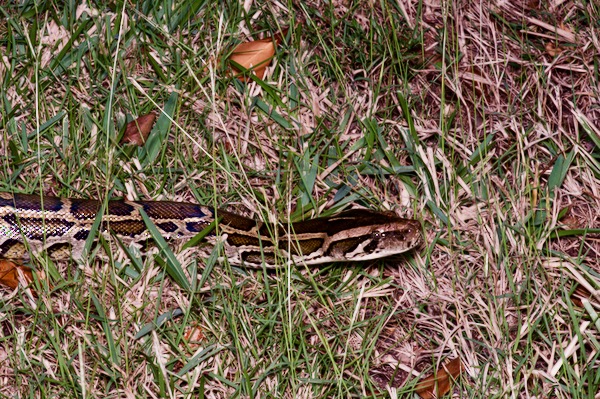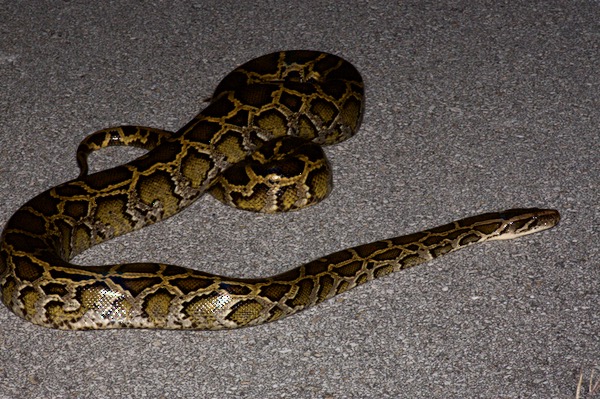Python bivittatus
—
Burmese Python
Also known as:
Southeast Asian Rock Python
This species was formerly considered to be a subspecies of Python molurus. Some authorities continue to use that arrangement.


I was in the Miami area for family reasons for a couple of weeks. One night I had the opportunity to borrow my sister-in-law's car and see if I could find any snakes in the Everglades. It was a cool-ish evening, and dry, and I didn't expect to see many snakes. And I didn't see many snakes, but I saw a lot of snake. This chunk o' snake was extended halfway onto the road when my headlights caught it. I pulled over quickly and ran back, only to see a snake-less road. Was I imagining things? No, definitely not. This portion of the road has a wide grassy shoulder, and there was my new acquaintance, moving at a leisurely pace toward the thick vegetation beyond the shoulder. It didn't really care that I took a few photos as it moved through the grass. I don't think it really cared about me at all. I wanted a photo that would show the whole snake, so I grabbed its body near the tail and gently pulled it back onto the pavement. It didn't really want to be on the pavement, and I didn't really want to get in an argument with it, so I got a few crappy photos and then let it slither away. I estimated that it was about nine feet long, which is on the large side but not extra large for this species.
Burmese Pythons were introduced to South Florida, probably repeatedly, by some combination of escaped and deliberately released pets and reptile breeder stock. There they seem to be wreaking all sorts of ecological damage, and a lot of money and attention is devoted to the concept of eliminating them. But it is clearly far too late for that; they have a well-established breeding population in a huge area that is impossible to survey, let alone control. Experts have estimated that tens of thousands now inhabit the Everglades.
Printed references:
- Bartlett, R. D., Bartlett, P. 2003. Florida's Snakes: A Guide to Their Identification and Habits
- Das, I. 2010. A Field Guide to the Reptiles of South-east Asia
- Das, I. 2012. A Naturalist's Guide to the Snakes of South-east Asia
- Holbrook, J. D. 2012. A Field Guide to the Snakes of Southern Florida
- Meshaka, W. E. Jr., Butterfield, B. P., Hauge, J. B. 2004. The Exotic Amphibians and Reptiles of Florida